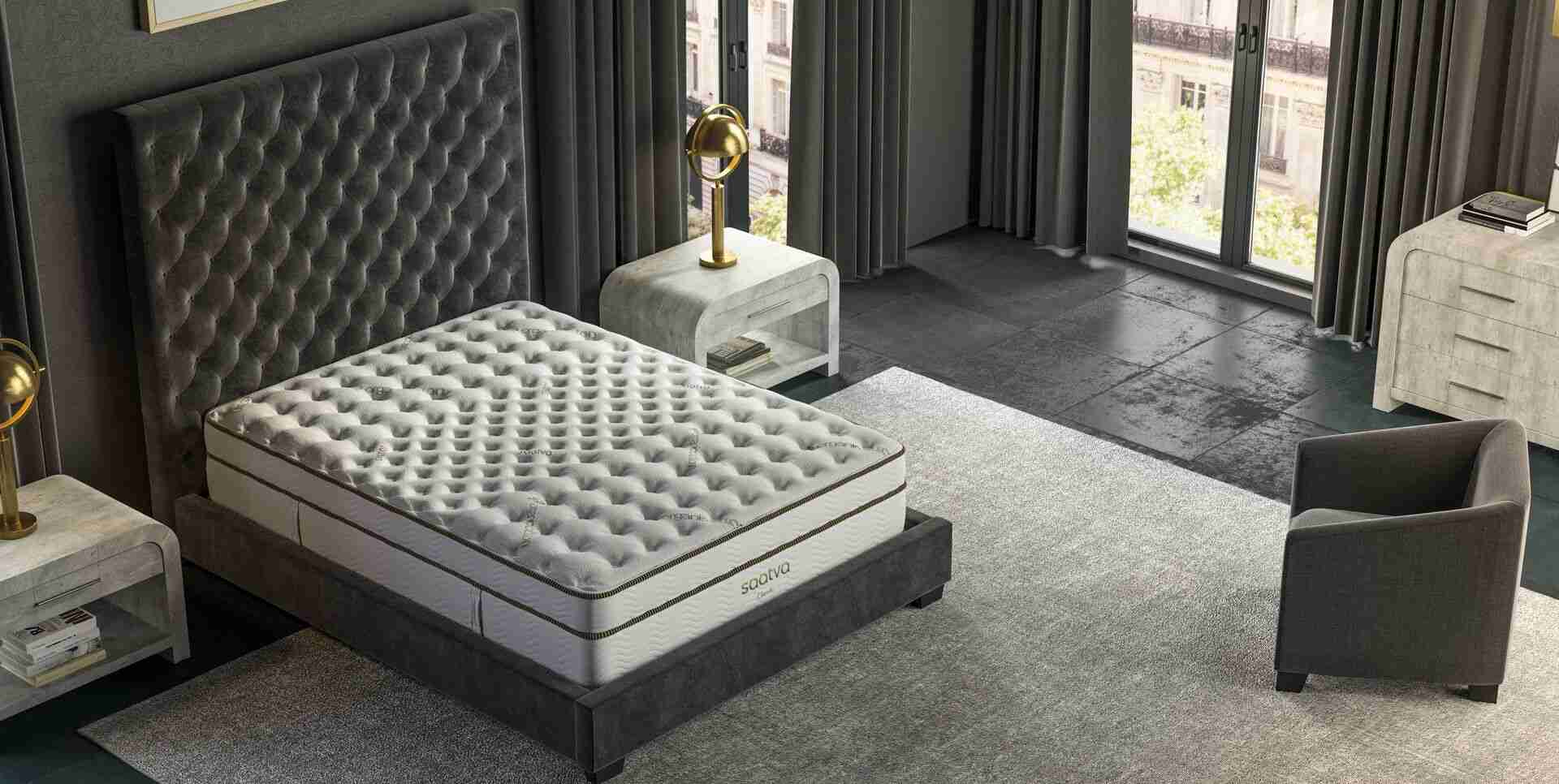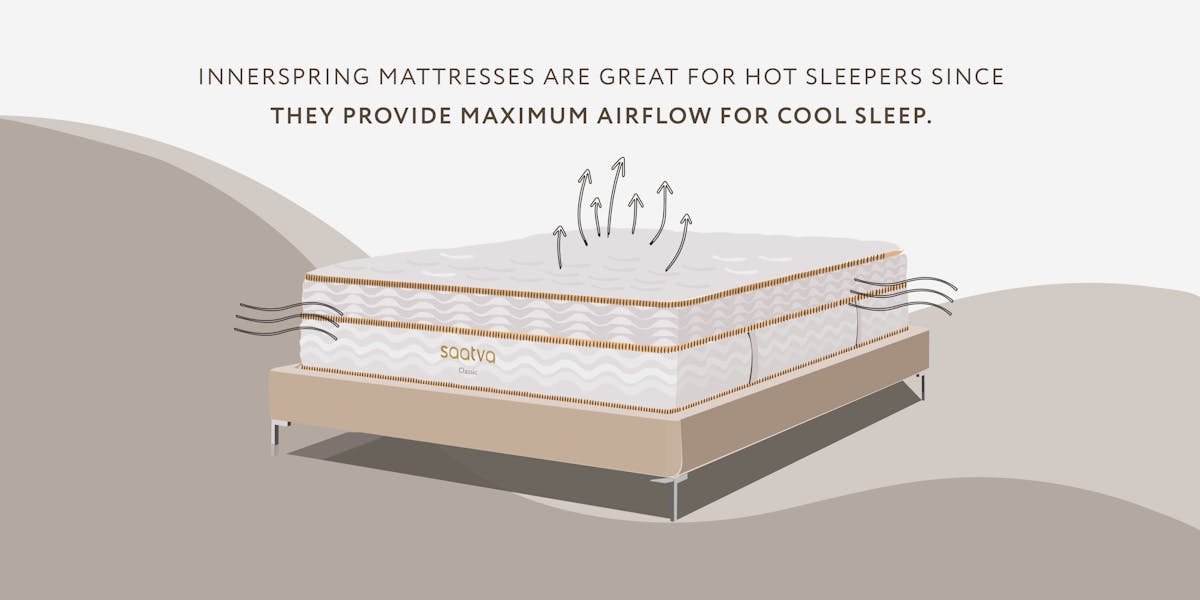Just like a good pair of jeans, the

America’s best-selling online luxury innerspring
will never go out of style. Of course, even classics have to adapt to changing times. Because of recent improvements—think high-tech materials, improved designs, and manufacturing methods that limit motion transfer and bounciness—today’s innerspring mattress is better than ever.
If you’re in the market for a new innerspring bed, take a look at our comprehensive mattress guide. Find out what’s between the covers and which type of sleepers it suits best.
What is an innerspring mattress?
An innerspring mattress takes its name from the metal support coils that form the core of the bed. Most innerspring mattresses today also contain layers made with other materials, such as memory foam and latex, for added comfort, performance, and durability. That essential quality of “springiness,” though, is the innerspring mattress’s defining characteristic.

Innerspring mattresses are also generally ideal for hot sleepers because of their breathability and good airflow. In fact, they tend to sleep cooler than both polyfoam and memory foam mattresses.
While innerspring mattresses are a great choice for most sleepers, it’s important to know exactly which one will be best for you and your sleeping habits.
Types of innerspring mattresses
There are a handful of components common to most innerspring mattresses. When comparing products, it’s best to consider the type of coil inside. Different coil systems create different comfort levels, firmness levels, and overall experiences with an innerspring mattress. Depending on your sleeping position, body type, and sleeping habits, one of these could be the best innerspring mattress for you.
The type and construction of coils have everything to do with how an innerspring mattress feels, how long it lasts, and how much it costs. There are four main categories of coils:
Bonnell coil mattresses
Also called “open” coils, these are the oldest and most basic type of mattress springs (remember those buggy seats?). Bonnell coils are shaped like an hourglass and often wired together to form a continuous unit. That makes them durable but not very good at controlling motion transfer. They’re also not ideal for relieving pressure points.
Innerspring beds made with Bonnell coils are usually on the firmer side. Because a firm mattress is ideal for stomach sleepers, they may enjoy resting on this type of mattress.
Keep in mind that Bonnell coil mattresses are less durable than other types of innerspring mattresses, making them best suited for kids who will eventually outgrow their childhood bed. This mattress type is also ideal for guest bedrooms as its usage will be limited to a few times a year in most cases.
Offset coil mattresses
Innerspring beds made from offset coils often come with a soft to medium-firm rating. Side sleepers will enjoy offset coil mattresses because they evenly conform to the body’s curves and relieve pressure points.
Like Bonnell coils, these are also hourglass in shape, but the bottom of the coil is offset when compressed to create a hinging effect. That hinging effect makes them better able to conform to the body’s curves.

Continuous coil mattresses
Continuous wire coils are the most similar to offset coils, but they have several rows of singular wires molded into the shapes of a circle. While they have a long lifespan, these coils provide significantly less support than most other mattresses available.
Continuous coil mattresses tend to be some of the firmest on the market, which may make them a fit for a stomach sleeper. However, they don’t provide as much support as most other innerspring mattresses types. Try pairing your continuous coil mattress with a thick traditional memory foam or gel memory foam mattress topper to fix this shortfall. This can help provide additional comfort and support temporarily.
Individually wrapped coil mattresses
These coils are individually encased in fabric, which means they can move independently and contour to the sleeper’s body much better than open coils. Because the coils aren’t physically attached to each other, they provide outstanding motion isolation.
That means your sleep partner won’t feel any tossing and turning that may take place during the night. This type of innerspring mattress is among the most durable types of innerspring mattresses.
Innerspring beds with individually wrapped coils come in a variety of comfort levels, making them a great choice for most sleep positions. Side sleepers should opt for a plush mattress with individually wrapped coils, while back sleepers should select a medium-firm mattress with individually wrapped coils.
Benefits of sleeping on an innerspring mattress
There are a lot of reasons why you’d want to choose an innerspring mattress over another type of bed. Here are some of the biggest benefits of sleeping on an innerspring mattress:
- Innerspring mattresses are familiar. When you’re making a purchase as important as the mattress you’ll sleep on every night, sometimes sticking with what you know can give you peace of mind. Even if you opt for a newfangled hybrid, you can expect that “classic” innerspring mattress feel, with a bounce that cradles your weight but never lets you sink in too deeply.
- Innerspring mattresses sleep cool. If you tend to “sleep hot,” an innerspring mattress is your best bet, as the space between coils allows plenty of air to circulate.
- Innerspring mattresses support a range of sleep styles. Whether you’re a side sleeper, back sleeper, or stomach sleeper, you can sleep comfortably on an innerspring mattress. And if you tend to shift positions during the night, the inherent “springiness” makes it easy to move across the surface of the mattress. (It also makes it easier to get out of bed, but we’re not sure that’s a good thing.)
- Innerspring mattresses are good for sex. The website sleeplikethedead.com rates innerspring and hybrids as two of the best types of mattresses to get busy on, owing to the ease of movement noted above, and the natural bounce and responsiveness.
- Innerspring mattresses are cost-effective. In general, high-quality innerspring mattresses cost less than high-quality memory foam and latex beds. A high-quality innerspring mattress starts at about a thousand dollars. (Learn more about how much to pay for a quality mattress.)
- Innerspring mattresses are durable. Innerspring mattresses offer great bang for your buck. A well-made innerspring mattress can last from 10 to 15 years.
Drawbacks of sleeping on an innerspring mattress
There are pros and cons to every type of mattress. An innerspring mattress may not be right for you if:
- You’re easily disturbed: If you have a sleep partner, any innerspring mattress that doesn’t contain individually wrapped coils is going to have substandard motion isolation characteristics. What that means: If one of you gets up to use the bathroom in the middle of the night, your partner is going to feel your movements.
- You have joint pain: For those with back pain or joint issues, you may find that other mattress types, like memory foam, provide you with more cushioning. An innerspring mattress probably won’t have the conforming capabilities to cradle those pressure points.
What else to consider when looking for an innerspring mattress
There are a few things you should consider before buying an innerspring mattress. To determine which one is best for you, you’ll want to take a look at the comfort layers, coil counts, coil gauges, lumbar support, and edge support of the mattresses on the market.
Comfort layers
There’s a lot more to an innerspring mattress than just the springs. In fact, what goes on top of the coils—typically some combination of foam, padding, and sometimes even more coils—is just as important when it comes to how comfortably you’ll sleep.
Depending on the number and type of layers, the mattress may be considered a “hybrid,” which signals that it contains a coil support system along with another material, typically memory foam. When evaluating innerspring mattresses, these are the layers you’re most likely to encounter:
- Comfort layer: The top layer of the mattress, intended to provide cushioning and pressure relief, the comfort layer is usually made from memory foam, latex, or another type of foam.
- Cooling materials: Because foams tend to trap body heat, some mattresses incorporate cooling technology (such as cooling gel or graphite) in the foam comfort layer.
- Comfort coils: Some innerspring mattresses (including the Saatva Classic) use “coil-on-coil” technology, which adds a second set of individually wrapped coils on top of the steel coil base. The thicker bottom coils provide a durable and stable support core, while the thinner top coils provide contouring for comfort and cut down on motion transfer.
- Pillow top: Yet another layer of cushioning on the top surface of the mattress. There are two types of pillow tops: Euro-style and standard. A conventional pillow top is sewn onto the top surface of the mattress, with a gap between the pillow top and the mattress itself. The padding of a Euro pillow top is inserted underneath the top cover of the mattress, flush with the mattress edges. In addition to giving the mattress a cleaner look, Euro tops won’t shift or lose shape the way a regular pillow top can.
- Cover: All of these layers and components come wrapped in an outer cover. For maximum sleep comfort, a mattress cover should be made of a material that is soft, breathable, and moisture-wicking.

Coil count and coil gauges
Other less important coil factors to consider: coil count and coil gauge. A higher number of coils used to be associated with better quality mattresses, but that’s not the case today. The materials used in the mattress and the type of coils are much more important indicators of innerspring mattress quality.
For example, an innerspring mattress could have a high coil count with springs made of low-quality steel. A general rule is to look for a minimum of 400 coils in a queen-size bed; the average is around 700. Anything too much higher than that likely won’t make a significant difference in comfort or support.
Coil gauge refers to the thickness of a coil. The higher the gauge number, the thinner and more flexible the spring. A higher gauge is a better option if you want a softer mattress, but a lower gauge usually lasts longer. Thicker springs are also a better choice if you’re on the heavier side since they provide stronger support. A coil gauge in the range of 12 to 15 should ensure an innerspring mattress can provide good comfort, support, and durability.
Lumbar support
The lumbar region of your back is located just above your hips. Lumbar support is crucial in order to preserve the natural curvature of the spine. Without it, your midsection (where most people carry their weight) will sink into the mattress and pull the spine out of alignment—a long-term recipe for back pain.
A mattress without lumbar support will also show signs of wear and tear more quickly. Look for an innerspring mattress with reinforcement in the center third section, such as denser foam or hidden steel wires, to support the added weight.
Edge support
Proper edge support makes it possible to comfortably and safely use every inch of the bed, whether sitting on the edge to put on your socks or sleeping next to the edge when your partner (or your dog) crowds the space. Edge support also prevents sagging and provides more durability. An innerspring mattress with edge support will have a layer of foam or heavier coils around the perimeter to bolster its structure.
Best sleeping positions for innerspring mattresses
It’s safe to say that one of the reasons innerspring mattresses have maintained their popularity throughout the years is that they support a wide range of sleep styles. Within the innerspring mattress category, look for these features depending on your preferred sleep position:
- If you’re a side sleeper: Side sleepers tend to need a softer, or more “plush” innerspring mattress to cushion pressure points created by the shoulders and hips.
- If you’re a back sleeper: Back sleepers do best on a medium-firm innerspring mattress, though they can find comfort on a wide range of firmnesses. The most important consideration for a back sleeper is proper lumbar support, so hips don’t sink too deeply.
- If you’re a stomach sleeper: Stomach sleeping is generally considered the least healthy position, but stomach sleepers can be comfortable with the right firmness level—namely, firm enough to keep hips from sinking and causing the spine to bow unnaturally.
The best base for innerspring mattresses
Speaking of support, your mattress needs it too. An innerspring mattress is usually paired with a foundation (a.k.a. box spring) or base. The most important thing is that it has a sturdy surface underneath, to keep the mattress from sagging and prolong its life. (In fact, some mattress warranties require the use of a specific type of foundation, and anything else will void the warranty.)
In addition to the standard combination of box spring and metal bed frame, innerspring mattresses are compatible with platform bases, slatted bases, and adjustable bases—though not every innerspring works with an adjustable base, so check before you make a purchase.
FAQs
Which is better: a coil or an innerspring mattress?
While an innerspring mattress with open coils provides general support, it’s not good at controlling motion transfer and relieving pressure points and it’s not very durable. A mattress with individually wrapped coils, however, contours to the body much better than open coils, provides good motion isolation, is very durable, and comes in a variety of comfort levels.
Where to find the best innerspring mattresses
Searching for a new mattress can be overwhelming. There are so many different mattress brands, sizes, and types on the market. Saatva offers a high-quality selection of products, including a wide variety of innerspring mattresses, accessories, and bedding. All of our mattresses come with a generous 365-night home trial as well as a lifetime warranty.
You can find our top picks for Saatva’s best innerspring mattresses and take our mattress quiz today to determine which one is right for you.











